Masukichi & Saburo Akai - 1973 founders of Akai
Bill Arhos - Arhos played a key role in the development of the musical institution, and served as executive producer of the show for 25 years.
The father of Austin City Limits, Bill Arhos, passed away on April 11 in Austin, Texas. He was 80.
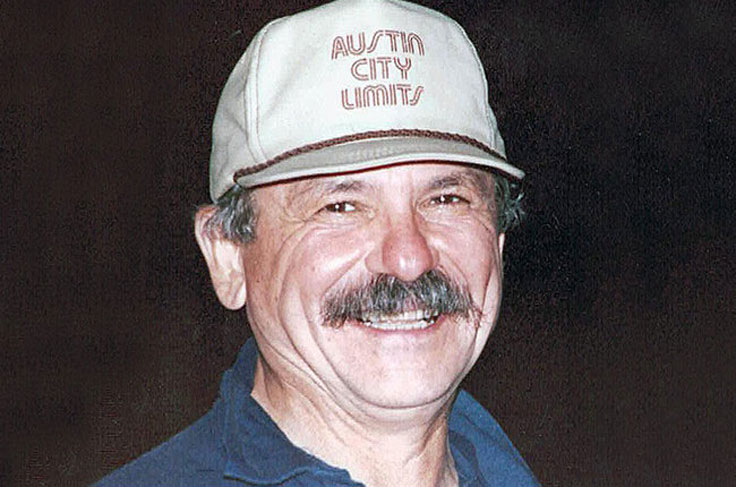 Arhos worked for nearly 40 years as an executive at the Austin PBS station KLRU-TV, beginning in 1961 with the station's launch and including a run from 1986 until his retirement in 1999 as president and general manager. He was executive producer of Austin City Limits from its start in 1974 up through 1999.
Arhos worked for nearly 40 years as an executive at the Austin PBS station KLRU-TV, beginning in 1961 with the station's launch and including a run from 1986 until his retirement in 1999 as president and general manager. He was executive producer of Austin City Limits from its start in 1974 up through 1999.
He also served on the boards of PBS and the Country Music Association. A graduate of Rice University, Arhos was honored by his alma mater in 2007 with the Distinguished Alumni Award. The pilot for Austin City Limits, featuring Willie Nelson, was shot in October 1974 and distributed to a network of about 50 PBS stations beginning in 1975.He also served on the boards of PBS and the Country Music Association.A graduate of Rice University, Arhos was honored by his alma mater in 2007 with the Distinguished Alumni Award. The pilot for Austin City Limits, featuring Willie Nelson, was shot in October 1974 and distributed to a network of about 50 PBS stations beginning in 1975. “The idea for Austin City Limits was not just his alone, but he brought it to life, and he kept the show going and growing through some difficult times,” saidACL executive producer and longtime colleague Terry Lickona. “Whether they know it or not, millions of music fans, artists and PBS viewers owe a debt to him for his enormous contribution to what's become a cultural institution.”
Arhos was inducted into the inaugural Austin City Limits Hall of Fame last year for his vision, passion and dedication to the show. He was honored at the show’s original studio home along with Nelson, Darrell Royal and Stevie Ray Vaughan and Double Trouble. Billboard April 14, 2015
Atkins, Chet (AES) 1924 - 2001
Peter Bang 1900 -1957 & Svend Olufsen 1897–1949 • founders Bang & Olufsen
Semi J. Begun (AES) 1905 - 1995
Emmanuel (Bert) Berlant (AES) 1911 - 1985
Emile (Emil) Berliner -1851 - 1929
John Boyers 1915 - 2012 • One of the founders of Magnecord
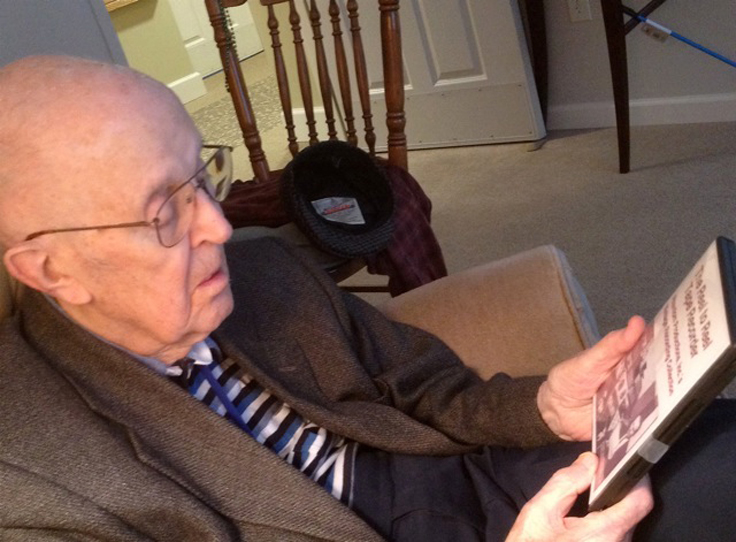 On September 29, 2012 I was saddened to receive word from Dave Boyers, that his Dad had passed away. Here is the message he sent out.
On September 29, 2012 I was saddened to receive word from Dave Boyers, that his Dad had passed away. Here is the message he sent out.
"Gentlemen,
The last remaining founder of Magnecord, Inc. has now passed into history. Dad has wanted to go be with my mother for some time now, suffering the ravages of Alzheimer's for several years. His wishes were finally granted.
To the degree he could understand it, it has been no small measure of pride that so many people have come to know and appreciate the work he did half a century ago to further the art and science of audio recording.
Similarly, the work all of you do to keep the memory of those early pioneers alive is not only worthwhile, but also gives others like Dad a sense that the efforts they made are not forgotten.
Best wishes to you all, Dave Boyers (John's son)
Charles Francis Brush Jr. 1849 - 1929 • founded Brush Development Company in 1930
Marvin Camras (AES) 1916 - 1995
Camras built his first recording device, a wire recorder, in the 1930s for a cousin who was an aspiring singer. Shortly afterwards he 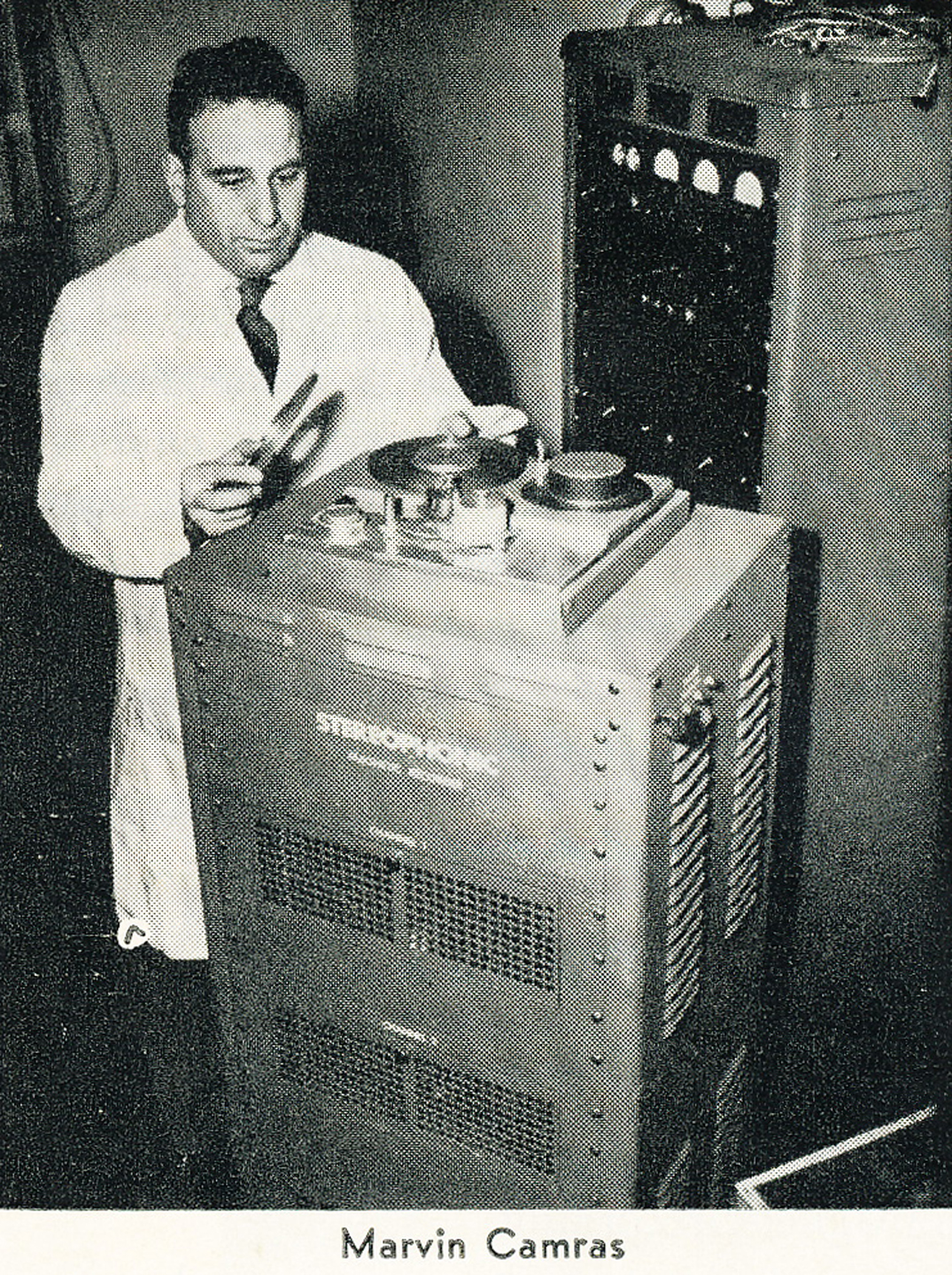 discovered that using magnetic tape made the process of splicing and storing recordings easier.
discovered that using magnetic tape made the process of splicing and storing recordings easier.
Camras's work attracted the notice of his professors at what is now Illinois Institute of Technology (IIT) and was offered a position at Armour Research Foundation (which merged with Lewis Institute in 1940 to become IIT) to develop his work.
Before and during World War II Camras' early wire recorders were used by the armed forces to train pilots. They were also used for disinformation purposes: battle sounds were recorded and amplified and the recordings placed where the D-Day invasion was not going to take place. This work was kept secret until after the war.
In June 1944 he was awarded US Patent number 2351004,[1] titled "Method and Means of Magnetic Recording". In all, Camras received more than 500 patents, largely in the field of electronic communications.
Camras received a bachelor's degree in 1940 and a master's degree in 1942, both in electrical engineering, from IIT. In 1968, the institution awarded him an honorary doctorate.
Talton R. Craig (1899 - 1952) 8 founded Craig Movie Supply Company, Craig - Panorama and co-founder of Roberts Electronics
Ray M. Dolby (AES) 1933–2013
Tom Dowd (AES) 1925 - 2002
Grover "Jeep" Harned (AES) 1930 - 2003 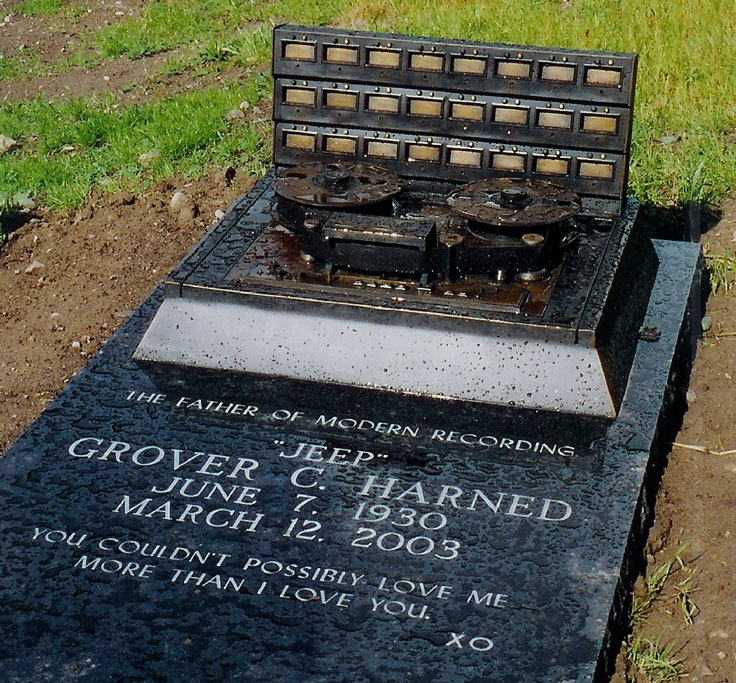
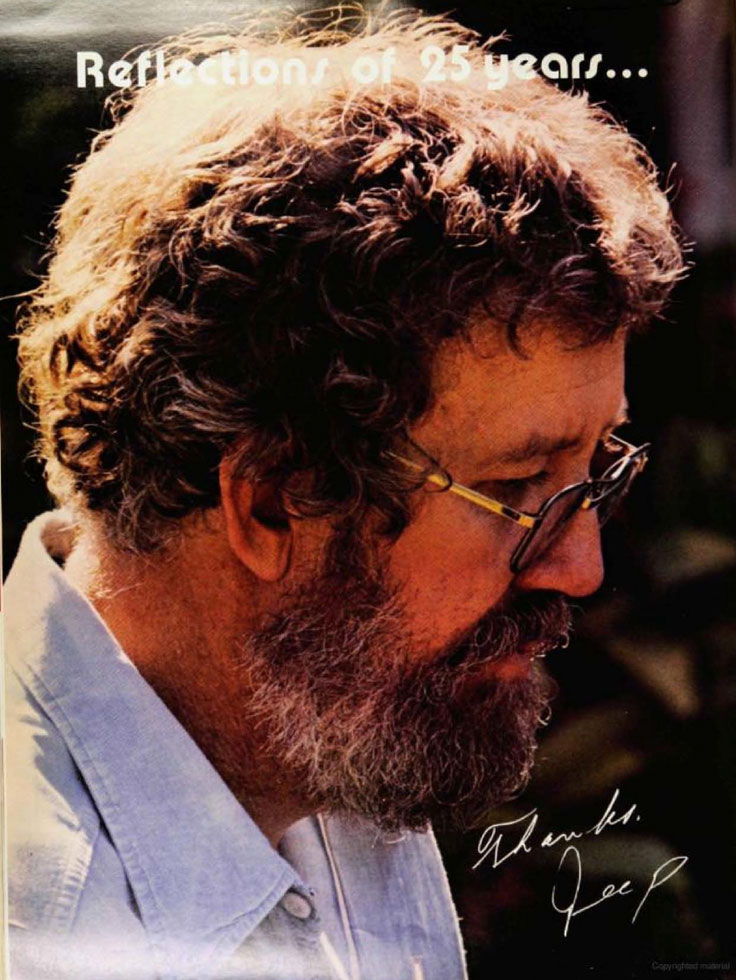 Grover C. Harned, who built a Fort Lauderdale hi-fi and record shop into a leading manufacturer of multi-track recording gear and helped usher in the era of professional audio, died of pneumonia on March 13 at a hospital near his home in Durango, Colo., his family said. He was 72.
Grover C. Harned, who built a Fort Lauderdale hi-fi and record shop into a leading manufacturer of multi-track recording gear and helped usher in the era of professional audio, died of pneumonia on March 13 at a hospital near his home in Durango, Colo., his family said. He was 72.
Tulsa, Okla., native Mr. Harned, known since childhood to friends and family as "Jeep," was a trained engineer with a talent for tinkering and constructing new electronic devices out of existing parts. He built sound recording consoles by hand at a storefront on Sunrise Boulevard that he opened with his first wife, Joyce Sutton Harned, in 1955. An early and regular client at the Harneds' Music Center Inc., was Mack Emerman, founder of Criteria Recording Studios in North Miami.
Harned-made equipment would become must-have in some of the world's most prestigious sound rooms: Criteria; Mastersound in Atlanta; and Fame Studios in Muscle Shoals, Ala. It also was used to capture milestone recordings such as James Brown's I Feel Good (1966) and Aretha Franklin's Respect (1967).
Mr. Harned went on to develop new techniques for assembling circuitry that modernized the manufacture of recording equipment. Those advances also transformed his storefront into MCI Corp. -- no relation to the phone company -- a global business with 300,000 square feet of factory floor space along West Commercial Boulevard.
"He was the first guy to build something that rolled off an assembly line," said Fort Lauderdale writer, musician and audiophile Dan Daley. "He began the industrialization of audio."
Mr. Harned ran a prosperous company with a resolutely casual dress code, said second wife Carla Kachigian Harned, who began working at MCI as a receptionist in 1970. She described her husband as someone who could design a product as well as the business plan to sell it, work the assembly line when needed, or fix the factory's sprinkler system by himself.
March 29, 2003 By Sean Piccoli Pop Music Writer, Sun Ssentinel
Julian Hirsch (AES) 1922 - 2003
Peter Paul Kellogg 1899 -1964 • Amplifier Corporation of America
Stefan Kudelski 1929 - 2013 Nagra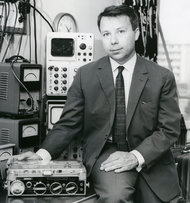
Stefan Kudelski, the inventor of the first professional-quality portable tape recorder, which revolutionized Hollywood moviemaking and vastly expanded the reach of documentarians, independent filmmakers and eavesdroppers on both sides in the cold war, died on Saturday in Switzerland. He was 83.
The Polish-born Mr. Kudelski was an engineering student at a Swiss university in 1951 when he patented his first portable recording device, the Nagra I, a reel-to-reel tape recorder, about the size of a shoe box and weighing 11 pounds, that produced sound as good as that of most studio recorders, which were phone-booth-size. Radio stations in Switzerland were his first customers.
The bigger breakthrough came seven years later, when Mr. Kudelski introduced a high-quality tape recorder that could synchronize sound with the frames on a reel of film. Mr. Kudelski’s 1958 recorder, the Nagra III, weighed about 14 pounds and freed a new generation of filmmakers from the conventions and high cost of studio production.
Along with the newly developed portable 16-millimeter camera, the Nagra recorder became an essential tool for the on-location, often improvisational techniques of New Wave directors like François Truffaut and Jean-Luc Godard, and American documentarians like D. A. Pennebaker, who used the Nagra to record the 1965 Bob Dylan tour featured in his classic film “Don’t Look Back,” released in 1967.
In various interviews, Mr. Pennebaker, Mr. Godard and Mr. Truffaut have all credited Mr. Kudelski with helping to make possible the informality and journalistic realism of their work.
Mr. Kudelski received Academy Awards for his technical contributions to filmmaking in 1965, 1977, 1978 and 1990, and Emmy Awards in 1984 and 1986.
In the 1960s, Mr. Kudelski’s firm also began making miniature recorders for what its online catalog calls “surveillance and security” work. The first of these pocket-size machines was the SN “Serie Noire,” which the company’s Web site boasts was “originally ordered by President J F Kennedy for the American secret services.”
The collection of bugging devices on display at the International Spy Museum in Washington, a privately financed archive run by former C.I.A. employees, includes a Nagra recorder obtained in the 1980s from Stasi, the East German internal security agency.
The Nagra’s value to customers like those was generally classified. But it received acclaim by consensus from professionals in the radio, television and film industries. By the early 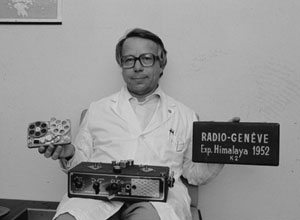 1960s, Nagras were the standard recording equipment in all three industries. They remained dominant until the advent of digital audio recorders in the 1990s. The company now makes digital recorders, as well as some analog tape devices, but does not rule the market as it once did.
1960s, Nagras were the standard recording equipment in all three industries. They remained dominant until the advent of digital audio recorders in the 1990s. The company now makes digital recorders, as well as some analog tape devices, but does not rule the market as it once did.
“There was virtually no film made from 1961 until the early ’90s that did not use the Nagra,” Chris Newman, an Academy Award-winning sound engineer, said on Wednesday. Mr. Newman used the machine in winning Oscars for “The Exorcist” (1973), “Amadeus” (1984) and “The English Patient” (1996). He also used one in making a celebrated 1971 action thriller, “The French Connection.”
“We would not have the movies we have today without it,” Mr. Newman said.
Stefan Kudelski was born on Feb. 27, 1929, in Warsaw. He escaped Poland with his family at the start of World War II and settled in Switzerland later. After earning a degree in physics and engineering, he began his company as an engineering design firm. It has since become a major Swiss manufacturer of media and security equipment.
His son André succeeded him as chief executive and chairman in 1991. In addition to André, he is survived by four other children, Isabelle, Marguerite, Henri and Irène Kudelski. His wife, Ewa, died in 2000.
Mr. Kudelski’s tape recorders were carried on several expeditions to Mount Everest. In 1960, the Swiss oceanographer Jacques Piccard took a Nagra aboard his deep-sea research submarine, Trieste, to record his impressions as he descended to 37,800 feet below the surface of the Pacific off Guam. It remains the deepest known place on the Earth’s ocean floor.
Leo de Gar Kulka (AES) 1921 - 1998
Harold W. Lindsay (AES) 1909 - 1982
Saul B. Marantz (AES) 1911 - 1997
Sir George Martin 3 January 1926 – 8 March 2016
An English record producer, arranger, composer, conductor, audio engineer and musician. He is sometimes referred to as "the Fifth Beatle" in reference to his extensive involvement on each of the Beatles' original albums. Martin had 30 number-one hit singles in the United Kingdom and 23 number-one hits in the United States.
He attended the Guildhall School of Music and Drama from 1947 to 1950, studying piano and oboe. Following his graduation, he worked for the BBC's classical music department, then joined EMI in 1950. Martin produced comedy and novelty records in the early 1950s, working with Peter Sellers, Spike Milligan and Bernard Cribbins among others.
Martin's career spanned more than six decades of work in music, film, television and live performance. He also held a number of senior executive roles at media companies and contributed to a wide range of charitable causes, including his work for the Prince's Trust and the Caribbean island of Montserrat.
In recognition of his services to the music industry and popular culture, he was made a Knight Bachelor in 1996.
(from the BBC Entertainment News) - "Following the 1970 break-up of The Beatles, Martin worked with artists such as Sting, Jose Carreras, Celine Dion and Stan Getz, as well as Lennon and McCartney on their solo projects.
By then he had set up his own company, AIR studios, which enabled him, for the very first time, to be able to receive royalties for his work.
In the late 1970s, Martin built a studio on the Caribbean island of Montserrat, and artists including Dire Straits and The Rolling Stones travelled there to record albums under Martin's respected guidance.
When Hurricane Hugo devastated both island and studio in 1989, Martin produced a benefit album to help raise funds for the victims.
Martin received a knighthood in 1996, and a year later, Elton John asked him to produce the reworking of his song Candle in the Wind for the funeral of Diana, Princess of Wales.
He persuaded the singer just to sit down in the studio and record it exactly as he had played it in Westminster Abbey. The resulting single was Martin's 30th number one record, the highest of any musical producer.
He retired two years later after producing what he decreed would be his final album, In My Life, a collection of Beatles songs, rearranged and recorded by a collection of singers, film actors and musicians.
However, he was not able to completely relax. In 2002 he was part of the team which put together the Jubilee concert at Buckingham Palace and in 2006 he supervised the remixing of 80 Beatles tracks for use by Cirque de Soleil in a Las Vegas stage show called Love.
In his career, George Martin worked with some of the best-known names in popular music - ranging from Jeff Beck, through Ultravox to the Mahavishnu Orchestra.
But his enduring legacy will be his work with The Beatles whose timeless sounds, as acknowledged by the band members themselves, owe much to his input as a musician, arranger and producer ." BBC Entertainment News more
Nozomu Matsumoto - 1905–1988 • founder Pioneer Electronics
Konosuke Matsushita (AES) 1895 - 1989
Robert Gerson Metzner
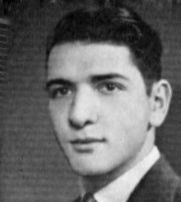

February 17,1917 - December 21, 2014
We are saddened to learn about the passing of Robert G. Metzner on December 21, 2014.
View his Son Richard's page about his Dad
February 11, 1917 - December 21, 2014 Entrepreneur, inventor and artist Robert Gerson Metzner died peacefully of natural causes on December 21, 2014 at home in Beverly Hills. Bob was born on February 11, 1917 in Detroit, Michigan. His father Abraham Metzner was a pediatrician. His mother Vera Pollasky Metzner was a nutritional specialist. The family moved to Los Angeles when he was 4. He soon became a technological prodigy building his first crystal radio at age 9 and obtaining a ham radio license and First Class Radio Telephone license at 16. Working in electronics to pay for his education, Bob earned a degree in electrical engineering at Caltech in 1938.
He married his beloved wife Esther in 1940. With her help as his secretary until their children started arriving, his career spanned the growth of the audio industry and he played a significant role in it. He patented numerous inventions in many audio formats, disk and tape. His first successful company Pacific Sound made playback equipment for the army during WWII.
In 1947 he founded Califone Corporation, which serves the needs of educators and other professionals by providing audiovisual recording and playback equipment for schools and industry. In addition, he began Roberts Recorders with Robert Craig, and formed one of the earliest successful partnerships between an American and Japanese (Akai) electronics company. His Metzner Starlight Turntable is still praised and collected by audiophiles.
He retired from business at age 42, but was far from finished with inventing and creating. He had studied sculpting in his spare time and was now able to pursue a new career as a sculptor living in Beverly Hills. His works in cast iron, bronze, fiberglass and other media are on display at UCLA, Caltech and in private collections. While "retired" from business,
Bob also patented the first modern gas/electric hybrid automobile in 1982 with Gerald Fields. When they presented a working prototype to the big three automakers in Detroit, they were told that the idea would never succeed. The Prius and other hybrids were introduced not long after their historic patent expired. Their prototype is now in the Petersen Automotive Museum in Los Angeles.
Bob's favorite pastime for most of his adult life was sailing. He owned many boats and won innumerable prizes and trophies racing on the Pacific Ocean. As with all of the other activities mentioned above, he attributed much of his success on land and sea to his engineering training at Caltech. Unlike Thomas Edison, on whose 70th birthday he was born, Bob was an inventor and businessman whose family was an important part of his life. He and Esther were happily married for almost 75 years. In addition to Esther, he is survived by his two adult children: Richard Metzner (Judy Davenport) and Carolee Goldberg (Edward Goldberg), four grandchildren: Jeffrey Metzner (Elise DiCarlo), David Metzner (Ariane Metzner), Jamie Goldberg, and Katie Hemphill (Charles Hemphill), and nine great-grandchildren.
Bob achieved all that he did and yet never stopped being a kind, humble, loving human being with a great sense of humor. The family will be holding a private memorial service at home and asks that in lieu of flowers contributions in Bob's honor be sent to Caltech, MC 5-32, Pasadena, CA 91125.
Published in the Los Angeles Times on Dec. 24, 2014
Clarence C. Moore (AES) 1905 - 1979
Akio Morita 1921 -1991 Founder of Sony
John T. (Jack) Mullin (AES)  (October 5, 1913 – June 24, 1999) was an American pioneer in the field of magnetic tape sound recording and made significant contributions to many other related fields. From his days at Santa Clara University to his death, he displayed a deep appreciation for classical music and an aptitude for electronics and engineering. When he died in 1999, he was buried with a rosary and a reel of magnetic tape. A 2006 documentary movie, Sound Man: WWII to MP3, was made about his life and contributions to sound recording.
(October 5, 1913 – June 24, 1999) was an American pioneer in the field of magnetic tape sound recording and made significant contributions to many other related fields. From his days at Santa Clara University to his death, he displayed a deep appreciation for classical music and an aptitude for electronics and engineering. When he died in 1999, he was buried with a rosary and a reel of magnetic tape. A 2006 documentary movie, Sound Man: WWII to MP3, was made about his life and contributions to sound recording.
After WW II , John "Jack" T. Mullin, who was in the US Army Signal Corp, brought back to the US, 2 German Magnetaphon reel to reel magnetic tape recorders. Mullin took the 2 Magnetophons apart and shipped them back to the US.
Following a number of demonstrations, Mullin attracted Bing Crosby's production folks. Crosby had been frustrated by the poor end quality of disc editing for his radio program. After Mullin demonstrated the ability to not only capture a great recording, but also to be able to edit the content with no loss of quality, the Crosby folks decided to adopt the technology. Mullin eventually went to work for Crosby as his Chief Engineer, using the 2 Magnetophons and the 50 reels of German tape. He edited the Crosby shows splicing the various tape pieces together as Crosby and his producers directed. Crosby expressed concern regarding there being only 2 recorders and a limited supply of tape. This eventually led to Crosby's backing of the Ampex company. Their first product was the Ampex 200A seen to right in our collection.
Georg Neumann (AES) 1898 - 1976
Williarn A. Palmer (AES) 1911 - 1996
Les Paul (AES) 1915 - 2009
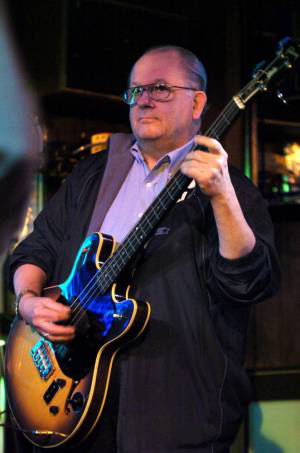
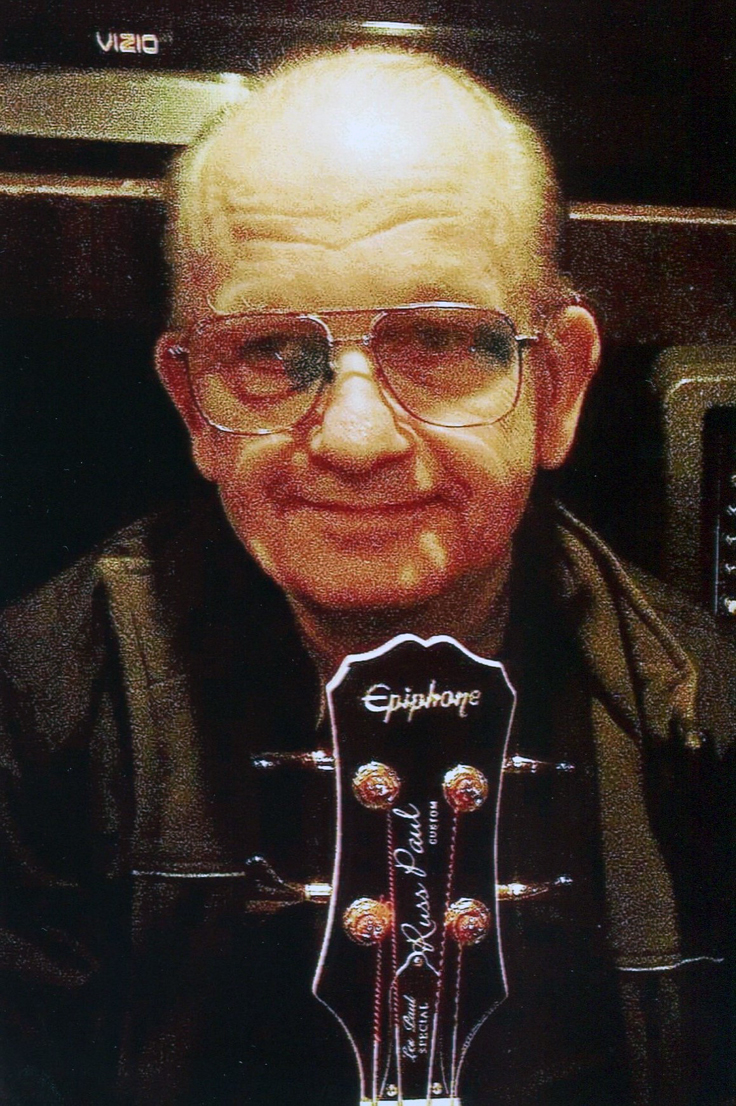 Lester "Rusty" Paul - Rusty Paul passed away December 31, 2015 born on June 16, 1941 in Chicago, IL. Longtime resident of Mahwah, NJ. Son of Les Paul and Virginia Webb. Following a battle with diabetes Russ passed away peacefully at the age of 74 on December 31, 2015 surrounded by family at Villa Marie Claire Hospice Care Center in Saddle River, NJ. Dear brother of Gene, Bobby and Colleen. Loving father of Stephen and his wife Maureen, Gary, Beth Anne and her husband Alex. Adored grandfather of Connor, Tucker, pre-deceased by Abigail, Madison, Aidan, Bryan and Kieran. Born and raised in Chicago, IL before moving to Mahwah, NJ. In his early years he attended Military School before joining the Army. He then formed a band with his brother Gene where they played throughout the New York/New Jersey area. He then obtained a position of recording engineer with Dick Charles Recording Studio, NY, NY. All the while continuing to work alongside his father doing Videography and sound, helping to preserve sound and extend the legacy. more
Lester "Rusty" Paul - Rusty Paul passed away December 31, 2015 born on June 16, 1941 in Chicago, IL. Longtime resident of Mahwah, NJ. Son of Les Paul and Virginia Webb. Following a battle with diabetes Russ passed away peacefully at the age of 74 on December 31, 2015 surrounded by family at Villa Marie Claire Hospice Care Center in Saddle River, NJ. Dear brother of Gene, Bobby and Colleen. Loving father of Stephen and his wife Maureen, Gary, Beth Anne and her husband Alex. Adored grandfather of Connor, Tucker, pre-deceased by Abigail, Madison, Aidan, Bryan and Kieran. Born and raised in Chicago, IL before moving to Mahwah, NJ. In his early years he attended Military School before joining the Army. He then formed a band with his brother Gene where they played throughout the New York/New Jersey area. He then obtained a position of recording engineer with Dick Charles Recording Studio, NY, NY. All the while continuing to work alongside his father doing Videography and sound, helping to preserve sound and extend the legacy. more
Harry Pearson, Founder of Absolute Sound, Dies at 77- Harry Pearson, a journalist and audiophile who founded The Absolute Sound, a magazine for connoisseurs of high-fidelity  audio in the 1970s and the locus of a backlash against CDs in the 1980s, died on Nov. 4 in Sea Cliff, N.Y. He was 77. Harold Hall Pearson Jr. was born in Charlotte, N.C., on Jan. 5, 1937, to Harry Pearson and the former Joyce Welborn. Taking up newspaper journalism after graduating from Duke University, he covered the environment for The Commercial Appeal in Pine Bluff, Ark., and then, beginning in the mid-’60s, for Newsday, on Long Island, where he worked for several years while freelancing for High Fidelity.
audio in the 1970s and the locus of a backlash against CDs in the 1980s, died on Nov. 4 in Sea Cliff, N.Y. He was 77. Harold Hall Pearson Jr. was born in Charlotte, N.C., on Jan. 5, 1937, to Harry Pearson and the former Joyce Welborn. Taking up newspaper journalism after graduating from Duke University, he covered the environment for The Commercial Appeal in Pine Bluff, Ark., and then, beginning in the mid-’60s, for Newsday, on Long Island, where he worked for several years while freelancing for High Fidelity.
Mr. Pearson published his magazine every other month from 1973 through the 1990s, a period that saw sweeping change in the audio world. Though its reach was modest by mass-circulation standards — it had 30,000 subscribers at its peak, he said — Absolute Sound was influential among consumers interested in, and in some cases able to buy, stereo systems costing $50,000 and up in today’s dollars.
Such so-called high-end equipment, arriving in the early 1970s, was marketed as capable of reproducing the sound of a live performance — or close to it. Testing those claims in his magazine, Mr. Pearson laid the foundations of a philosophy and vocabulary that helped give rise to a worldwide subculture of high-end audiophiles.
He wrote about recorded music with the conviction and nuance that food critics brought to haute cuisine, assessing qualities of depth, naturalness and “three-dimensionality” in the sound made by some stereo components and not others. When all those intangibles came together in the right way, he said, they produced “absolute sound,” which he defined as “the sound of actual acoustic instruments playing in a real space.”Mr. Pearson disapproved of some innovations. He disliked multitrack recording, for example, saying it was at odds with human biology. “We have two ears,” he wrote. “We don’t have five ears or 25.”
He accused mainstream audio publications like Stereo Review and High Fidelity of pandering to manufacturers to protect their advertising revenue. (Mr. Pearson initially refused to accept advertising but relented after a few years, though vowing not to soften his analysis.) And like his fellow critic J. Gordon Holt, the publisher of Stereophile magazine, whom he considered a role model, Mr. Pearson was often labeled old-fashioned.
The arrival of the compact audio disc in the early 1980s gave him his greatest subject as a critic and brought him credit in the wider world for knowing what he was talking about. The digital coding and laser-beam technology of CDs was lauded as a friction-free alternative to the scratching-and-skipping-plagued vinyl record. Mr. Pearson was one of the first to describe the loss of nuance and detail that came with friction-free sound, and he mounted a relentless critique in his magazine. Over the next decade he won many audio engineers and music critics to his side. In The New York Times in 1992, Edward Rothstein characterized Mr. Pearson as a kind of unofficial spokesman for an “impassioned rear guard, a group of music lovers of extreme views, an organization of Luddite fanatics” at war with the CD.
Mr. Rothstein credited Mr. Pearson’s criticism with spurring improvements in CD technology. And by 1998, Mr. Pearson himself was reconciled, telling The Globe and Mail of Toronto: “I still prefer records because, at this point, a good analog disc has more information — subtle dynamics, harmonic richness, natural timbre — than a CD. Yet CDs have improved so much over the past 15 years that digital has become a parallel universe to analog.”
He sold The Absolute Sound in 1998; it continues to be published in print and online. Mr. Pearson is survived by a sister, Loretta.
In an interview last year with the online journal High Fidelity Report, Mr. Pearson said that audio technology — no matter how expensive or state-of-the-art — was merely the means to an end. Good equipment, he said, “allows you to become part of the music.” Technology critics, who test and write about such equipment, are, he said, “like guides in the Amazonian jungle.”
“What we do is say, ‘There is a tiger over there in the bushes.’ You can hear it with your ears or see it with your eyes. What we do is point out what is there.”
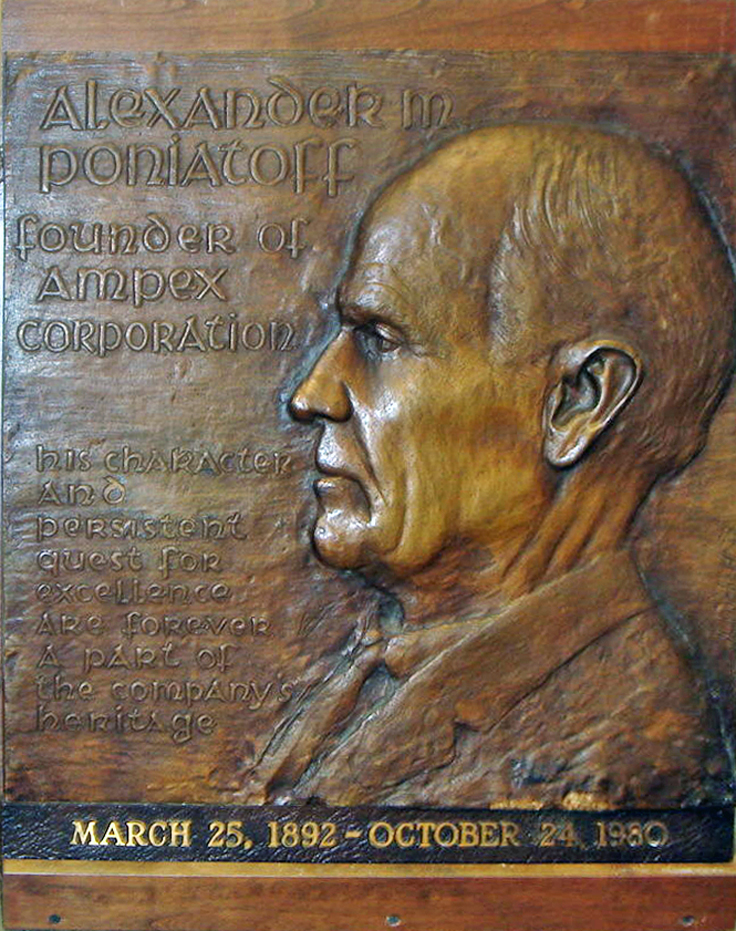
Alexander M. Poniatoff (AES) 1893 - 1981
Solid bronze plaque (right) bust of the founder of Ampex Corporation. This plaque was hanging on the wall in the main lobby as you entered Ampex Head Quarters. The size is 29 "x 22 " and weighs 48 pounds. The owner of the plaque worked at Ampex for 34 years and when Ampex was sold he said, “I removed it from the wall and saved it from getting thrown in the dumpster.”
Bill Porter (AES) 1931–2010
Milton T. (Bill) Putnam (AES) 1920-1989
Phil Ramone (AES) 1934–2013
Peter A. Rasmussen founder of Viking
Richard Howland Ranger (AES) 1890 - 1962
(13 June 1889 – 10 January 1962) was an American electrical engineer, music engineer and inventor. He served in the U.S. Army Signal Corps during World War I, earning the rank of Major. After the war, he  attended the Massachusetts Institute of Technology (MIT) from 1919 to 1923.
attended the Massachusetts Institute of Technology (MIT) from 1919 to 1923.
As a designer for the Radio Corporation of America (RCA), in 1924, Richard Ranger invented the wireless photoradiogram, or transoceanic radio facsimile, the forerunner of today’s fax machines. A photograph of President Calvin Coolidge sent from New York to London in November 1924 became the first photo picture reproduced by transoceanic radio facsimile. Commercial use of Ranger’s product began two years later.
In 1930, he formed a company, Rangertone, Inc., in Newark, New Jersey. The company, which marketed the electronic 'Rangertone Organ', was sold after his death, and remains privately owned as Rangertone Research, Inc.
In 1932, he invented the NBC chime machine, an automatic device to reproduce the familiar hand-struck NBC chimes used by the National Broadcasting Company (NBC) radio network. By connecting his electrically operated chimes with outdoor loudspeakers, he was later able to create the effect of church bells. He also did other work relating to electronic organs.
During World War II, he returned to the U.S. Army Signal Corps as a Colonel and was put in charge of radar and communications at the Radio and Radar Test Labs in Orlando, Florida. He later went to Europe as part of Field information Agency, Technical, an investigative team between 1944 and 1946 to examine German advances in electronics and wrote a series of technical reports on electrical components, communications, television, and (most significantly) magnetic tape recording.
After the war, Ranger's work led to further development of magnetic tape recorders. He developed a product using the German technology, and demonstrated it to potential users, including the members of the Institute of Radio Engineers, the National Broadcasting Company, the Radio Corporation of America, the American Institute of Electrical Engineers, and individuals like singer Bing Crosby.
His subsequent refinements led to improved synchronization of sound and visual portions of films. The Academy of Motion Picture Arts and Sciences presented Ranger with an Oscar in 1956 for his development of the tape recorder and synchronization of film and sound.
Richard H. Ranger was inducted into the New Jersey Inventors Hall of Fame in 1997.
Emil Rathenau 1838 - 1915 Founded AEG
John J. Scully ( - 1989) & his son Lawrence J. (Larry) Scully (1906 - 1989) founded Scully Recorders
Fritz Sennheiser (AES) 1912–2010
Stanley N. Shure (AES) 1902 - 1996
 Mr Michael D. Spitz • ATR Services/ATR Magnetics • 08/20/1954 - 10/12/2013
Mr Michael D. Spitz • ATR Services/ATR Magnetics • 08/20/1954 - 10/12/2013
Michael D. Spitz, 59, of York, died Saturday, October 12, 2013 at York Hospital, following a courageous battle with cancer. He was the husband of Bette L. (Ehrlich) Spitz, with whom he celebrated a 25th wedding anniversary November 14, 2012.
A Memorial Service will be held at 2:00 PM, Wednesday, October 16, 2013, Temple Beth Israel, 2090 Hollywood Drive, York.
Mike was born on August 20, 1954 in York a son of Lillian B. (Klein) Spitz of York and the late George A. Spitz.
He was a 1972 graduate of York Suburban High School and had attended York College.
Mike always had a passion for music recording and was the founder and co-owner of ATR Services and ATR Magnetics, (atrservice.com) both of York. He founded ATR Services, a company that manufactures mechanical and electronic products for analog recorders in San Mateo, CA, in 1991. In 2005, Mike also founded ATR Magnetics, these companies will continue to carry on that passion. He was a worldwide respected engineer, and has worked with many music professionals in the recording industry, to develop many products that preserve the quality of sound recording.
Mike was a devoted and loving husband, father, son and brother to his family. Besides his wife and mother, he leaves a daughter, Lauren N. Spitz; a son, Mark B.G. Spitz; a sister, Alyce L. Soffer and a nephew David B. Soffer all of York.
The family requests in lieu of flowers that memorial contributions be made to the SPCA of York County, 3159 Susquehanna Trail North, York, PA 17406 or to a charity of your choice.
The Geiple Funeral Home, Inc. 53 Main Street, Glen Rock is in charge of the arrangements. Condolences may be shared at geiple.com.
John Stephens 1930-2007 • founded Stephens Electronics, Inc.

Willi Studer 1912 - 1996 Founder of Studer/ReVox
Joel Tall - Editall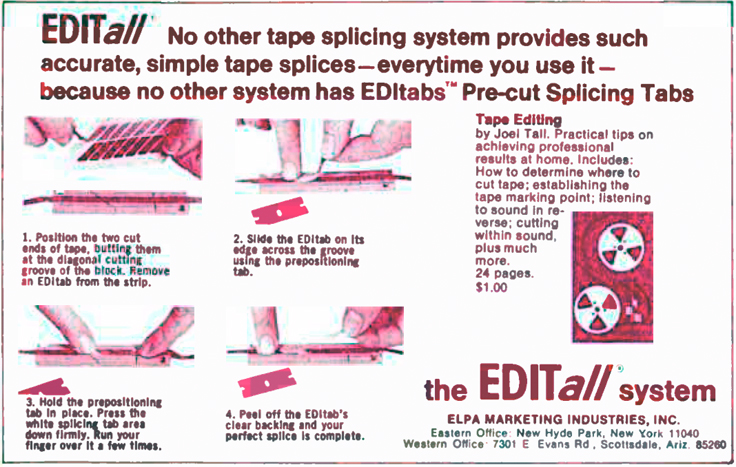
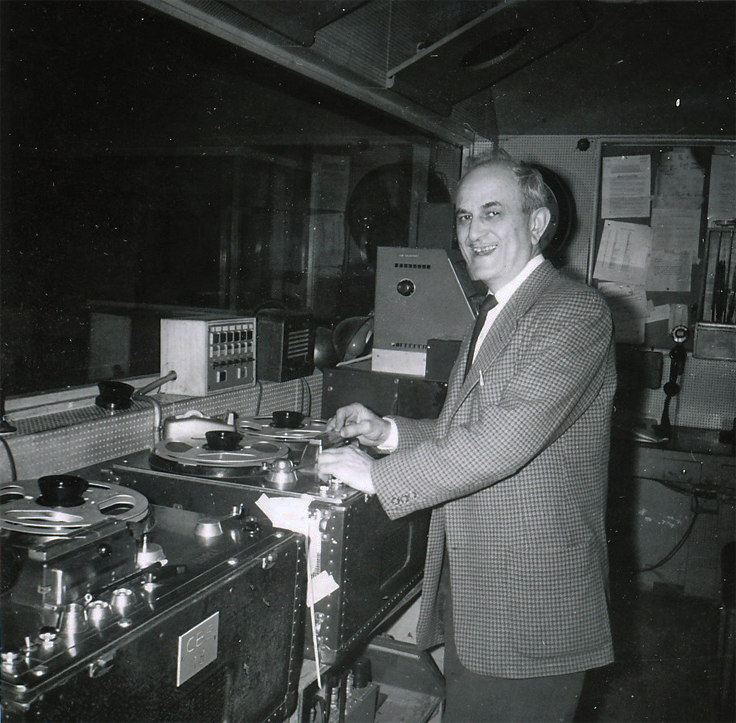
Joel Tall was born on April 17, 1905 and passed away in December 1986. He was married to Leona B. Tall and was survived by one daughter Benita J. Kaplan. Leona helped Joel Tall found The Tall Company in the 1950's.
Benita Kaplan has generously donated some of Joel Tall's personal papers and photo to our Museum of Magnetic Sound Recording.
In 1950 Joel Tall filed U.S. Patent #US 2599667 A for his Splicing Block stating "This invention relates to splicing blocks, such as are used in splicing film and sound recording tape, and specifically it refers to a block which is particularly suitable for editing sound recording tape." View the full patent More information on Joel Tall
Hisashige Tanaka 1799 - 1881 • founder of Toshiba
Vebjørn Tandberg 1904 - 1978 • founded Tanberg
Katsuma Tani founder of Teac Corporation
Willi Studer (AES) 1912-1996
Andrew Wollensak 1862 -1936 • founder of Wollensak (became Webcor)
Thank you for viewing our site! We hope you have found our information helpful and interesting.


![]()